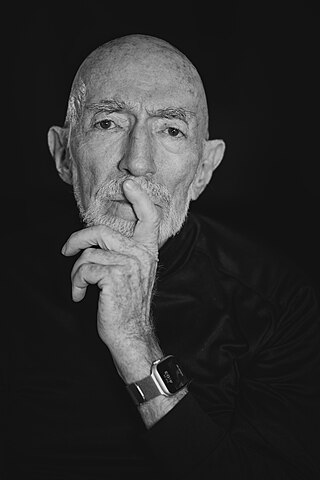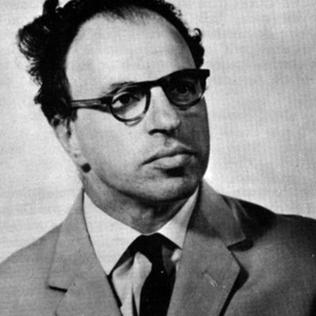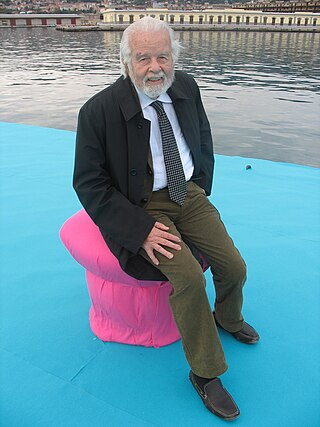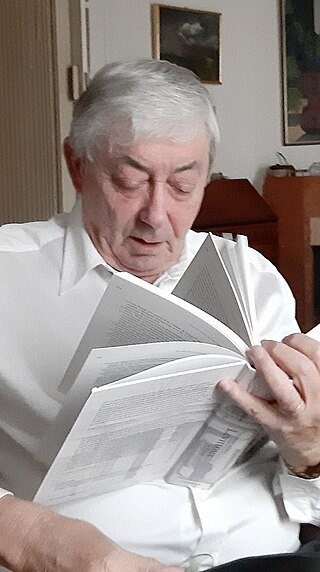Related Research Articles

Kip Stephen Thorne is an American theoretical physicist and writer known for his contributions in gravitational physics and astrophysics. Along with Rainer Weiss and Barry C. Barish, he was awarded the 2017 Nobel Prize in Physics for his contributions to the LIGO detector and the observation of gravitational waves.

Sir Hermann Bondi was an Austrian-British mathematician and cosmologist.

Leopold Infeld was a Polish physicist who worked mainly in Poland and Canada (1938–1950). He was a Rockefeller fellow at Cambridge University (1933–1934) and a member of the Polish Academy of Sciences.

André Lichnerowicz was a French differential geometer and mathematical physicist. He is considered the founder of modern Poisson geometry.

Demetrios Christodoulou is a Greek mathematician and physicist, who first became well known for his proof, together with Sergiu Klainerman, of the nonlinear stability of the Minkowski spacetime of special relativity in the framework of general relativity. Christodoulou is a 1993 MacArthur Fellow.

Education has been of prime interest to Poland's rulers since the early 12th century. The catalog of the library of the Cathedral Chapter in Kraków dating from 1110 shows that Polish scholars already then had access to western European literature. In 1364, King Casimir III the Great founded the Cracow Academy, which would become one of the great universities of Europe. The Polish people have made considerable contributions in the fields of science, technology and mathematics. The list of famous scientists in Poland begins in earnest with the polymath, astronomer and mathematician Nicolaus Copernicus, who formulated the heliocentric theory and sparked the European Scientific Revolution.
In general relativity, the sticky bead argument is a simple thought experiment designed to show that gravitational radiation is indeed predicted by general relativity, and can have physical effects. These claims were not widely accepted prior to about 1955, but after the introduction of the bead argument, any remaining doubts soon disappeared from the research literature.
Valentine "Valya" Bargmann was a German-American mathematician and theoretical physicist.
Jerzy Franciszek Plebański was a Polish theoretical physicist best known for his extensive research into general relativity and supergravity.

Vinod Johri was an Indian astrophysicist. He was an eminent cosmologist, a retired professor of astrophysics at Indian Institute of Technology, Madras and an emeritus professor at Lucknow University since 1995. Johri had over 75 research publications and articles published in pioneering journals. His major contributions in cosmological research included 'power law inflation, genesis of quintessence fields of dark energy and phantom cosmologies'. He was the co-author of the first model of power law inflation in Brans–Dicke theory along with C. Mathiazhagan. He was honored by Uttar Pradesh Government by Research Award of the Council of Science & Technology (CSIR).
Achilles Papapetrou was a Greek theoretical physicist, who contributed to the general theory of relativity. He is known for the Mathisson–Papapetrou–Dixon equations, the Majumdar–Papapetrou solution, and the Weyl−Lewis−Papapetrou coordinates of gravity theory.

Paolo Budinich was an Italian theoretical physicist. Born in Lussingrande to a family of sailors, he grew up and studied in Trieste, where the family resided and his father Antonio Budini taught in the local high school, which Paolo attended until 1934. He later began his studies at Università Degli Studi di Pisa graduating from the Scuola Normale Superiore in 1938, with a thesis written under the direction of Leonida Tonelli.
Felix Arnold Edward Pirani was a British theoretical physicist, and professor at King's College London, specialising in gravitational physics and general relativity. Pirani and Hermann Bondi wrote a series of articles that established the existence of plane wave solutions for gravitational waves based on general relativity.

Ivor Robinson was a British-American mathematical physicist, born and educated in England, noted for his important contributions to the theory of relativity. He was a principal organizer of the Texas Symposium on Relativistic Astrophysics.
Andrzej Sobolewski is a Polish physicist and academic working at the Institute of Physics of the Polish Academy of Sciences in Warsaw. He is a fellow of the Alexander von Humboldt Foundation and Foundation for Polish Science as well as a member of the National Science Centre.
Andrzej Marek Kossakowski was a Polish theoretical physicist and a professor at the Nicolaus Copernicus University. He was best known for his work on open quantum systems.

Richard Kerner is a French theoretical physicist andProfessor Emeritus of Pierre and Marie Curie University whose research extends into gravitation, cosmology, field theory, solid-state physics, noncommutative geometry, quantum mechanics and mathematical and theoretical biology.
Jerzy Lewandowski was a Polish theoretical physicist best known for his extensive research into general relativity and quantum gravity.

Włodzimierz Marek Tulczyjew was a Polish-Italian physicist and mathematician, known for his contributions to the geometric formulation of classical mechanics and field theory. He was a professor emeritus of mathematical methods of physics at the University of Camerino and a member of the Academy of Sciences of Turin.
References
- ↑ Radiation and boundary conditions in the theory of gravitation, Bull. Acad. Pol. Sci., S´erie sci. math., astr. et phys. VI (1958), 407–412.
- ↑ Chrusciel et al "The Trautman-Bondi mass of hyperboloidal initial data sets" Adv. Theor. Math. Phys. 8 (2004) 83–139
- ↑ Trautman, Andrzej. "Short autobiography". Trautman's website. Retrieved August 5, 2005.
- ↑ Trautman, Andrzej. "Short autobiography". Trautman's website. Retrieved August 5, 2005.
- ↑ Ivor Robinson, Andrzej Trautman, "Spherical Gravitational Waves". Phys. Rev. Lett.4 pp. 431–432 (1960).
- ↑ https://pubs.aip.org/physicstoday/article/68/6/11/415099/Historical-note-on-fiber-bundles
- ↑ "About Us". World Cultural Council . Retrieved November 8, 2016.